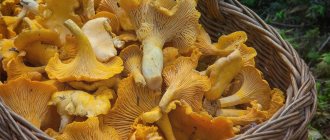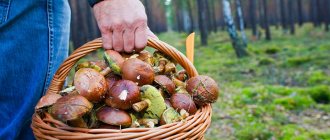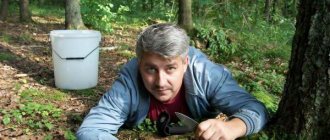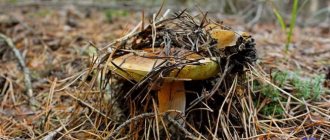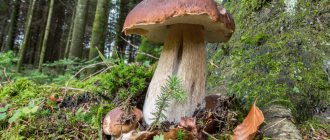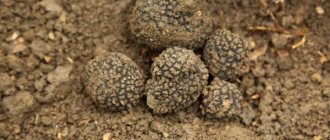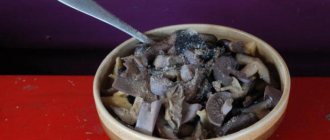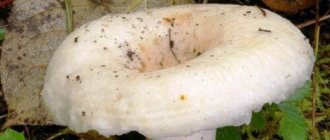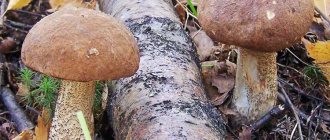Important information about mushrooms
First, a little introductory course.
- For those who have forgotten or don’t know, let me remind you that mushrooms occupy a special group in nature - this is the kingdom of fungi, that is, they have characteristics of both plants and animals.
- Mushrooms are divided into poisonous, edible, inedible, and conditionally edible. Those that are approved for food contain a lot of protein, vitamins, microelements and other beneficial properties. It is important to be able to distinguish edible ones from false ones.
- All mushrooms are good absorbents, that is, they easily absorb toxic substances, both from the ground and from the air. Therefore, you should not collect mushrooms along roads or near landfills in order to avoid absorbed exhaust gases and toxic substances.
- It is easy to get poisoned by mushrooms because many of the poisons they contain cannot be treated with heat. Mushroom picking near large industrial cities is also not recommended.
- If you are not sure about a mushroom, it is better not to take it.
I never buy mushrooms at the market because it is difficult to determine where they were collected.
Where to look for mushrooms in Kuban
Mushrooms also grow in Kuban. It turns out that there are more than 600 species in the Krasnodar region. And only 40 of them are edible. Can you imagine? In the Moscow region there are 10 times fewer of them. That is, it turns out that almost all species gathered in Kuban :-). I doubted...
The Tuapse, Apsheronsky, Sochi districts are recognized as the most mushroom in the region, where it is humid, the villages of Dakhovskaya, Smolenskaya, Kaluzhskaya, Goryachiy Klyuch, they say that there are a lot of whites in the Labinsky district. Most often they travel from Anapa towards the villages of Gostagaevskaya and Varenikovskaya. But history is silent about Anapa. In Supsekha there are no mushrooms.
The resort in the mushroom rating looks like a poor relative. You understand, when there are no forests, no rain, but there is heat and dryness, then what kind of mushroom will want to grow here. But we want mushrooms; years of living in Siberia and the North have given us an excitement and passion for forest production. Not to mention how delicious it is to put salty, glossy-looking russula the size of a fingernail into your mouth. Delicacy!
We didn’t look for mushrooms on the Kola Peninsula, we simply came to the forest-tundra and collected baskets full of them. Although there were crop failures and I had to search for boletuses, boletuses, russula, and trumpets, and it was always a pleasure. They prepared a lot, but during the long polar winter everything was quickly destroyed.
Having settled on the coast, we immediately checked the nearby area for the presence of mushrooms. And, of course, against the background of the northern mushroom riot, the southern ones seemed to us a complete misunderstanding. Therefore, for several years such production was neglected altogether.
This year, the beginning of September turned out to be relatively rainy, the nights were cold, and the day was not as hot as usual. Mushrooms have appeared on the market, which means it’s time.
When to collect honey mushrooms 2022 in the Krasnodar region?
If it’s the end of July outside, it’s time to go in search of edible honey mushrooms. Thanks to group growth, you can find the fruits of nature not only in the forest belt, but also in meadows, fields, and even near plots.
Summer honey mushrooms grow exclusively from July to September. Autumn subspecies begin to bear fruit from the end of August and continue to delight local residents until the first frost. Winter mushrooms can be found even in January, provided that the temperature does not drop below 10 degrees below zero.
In 2022, mushroom pickers are gaining a lot of mushrooms, posting photos of their achievements on social networks. And so that beginners don’t wander through the forest in vain, it’s enough to use some basic tricks:
1) find a group of mushroom pickers in Krasnodar; 2) look at the latest reviews and photo reports to draw a conclusion about the yield; 3) find the coordinates to go to the fertile forest.
Mushrooms of the Anapa region
We also set off in search of the mushroom kingdom in the vicinity of Anapa.
Mushroom places near Nizhnebakansky
We are driving towards Krymsk, passing the village of Nizhnebakansky, which is about 40 km from Anapa. Here is the forest.
As you can see, everything is still green, the hawthorn berries are ripening, the Indian summer continues and touches the face of every forest traveler with the languid embrace of cobwebs. The day is quiet and sunny.
We go deep into the forest, remember, the further into the forest, the more firewood, mushrooms and the safest ones.
The forests here are dark, dense, clogged with bushes and thorns, the terrain is rugged: holes, gullies, walking in them is not much fun.
Often you have to climb uphill or wade through thickets.
Hooray!!! Here is the first fungus:
Russula hid in the leaves:
Although along the curved edges it even looks like a small weight. They are the same family.
I always cut off the mushroom at the root, being careful not to destroy the mycelium even with the stem, if I am not sure of its edibility.
So, slowly moving forward, we collect what we come across.
Mainly boletus and russula. I love russulas that are dense, unopened and small like this:
We went out into the clearing and met a turtle:
Looks about 300 years old, maybe Tortilla herself went for a walk
